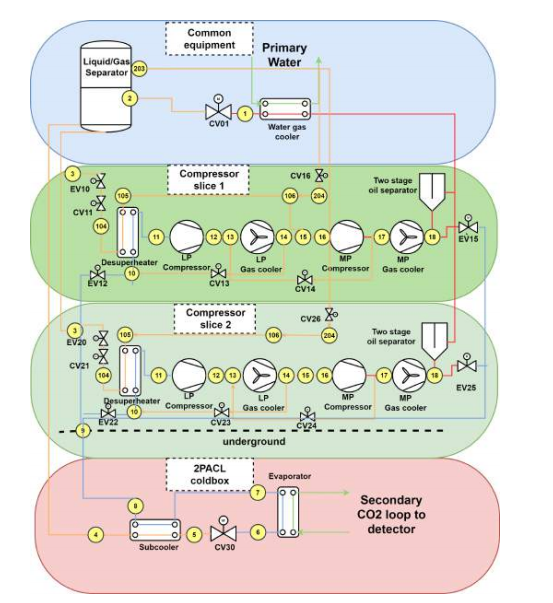The LHC transition to transcritical CO2 cooling technologies
A new generation of CO2 cooling for a new generation of LHC silicon detectors: a CO2 booster / CO2 evaporative (pumped) system will be adopted to cool the newly designed silicon detectors for ATLAS and CMS trackers by 2026.
CERN, the European Organisation for Nuclear Research, runs four main detectors to conduct experiments in the world’s most powerful particles accelerator: the Large Hardon Collider (LHC). The LHC is a 27 km long circular tunnel located at 100 m below the ground between France and Switzerland. To carry out in-depth research into particle physics, CERN continuously experiments with the four detectors: ATLAS, CMS, LHCb and ALICE. CERN has started its journey to more climate-friendly cooling solutions using CO2 as a natural refrigerant since the early 2000s, when the Dutch National Institute for Subatomic Physics (Nikhef) developed the 2-Phase Accumulator Controlled Loop (2PACL) 1 to cool the Alpha Magnetic Spectrometer (AMS) tracker detector, which has been operating in space since 2008, and the vertex Locator (VELO) ofthe LHCb detector, which has been operating since 2011. The 2PACL system was then applied to cool the ATLAS and CMS detectors in 2014 and 2016, respectively. The 2PACL system consist of a two-phase pumped-loop cycle, also known as the CO2 evaporative cooling technique. Bart Verlaat from CERN stated that CO2 as a refrigerant is suitable to ensure the thermal management of detectors as it has many advantages in adddition to being a natural refrigerant with a very low GWP. Indeed, CO2 has excellent heat transfer properties, which means that small size pipes can be used, making the cooling system more compact. Consequently, the amount of material inside the detector is reduced, thus improving detector performance. Although, 2PACL has shown great performance in cooling the three main detectors, HFCs are still used in the chiller which condenses the evaporated CO2 of the cooling system extracting heat from the detectors.
CERN has always sought to adopt environmentally friendly refrigerants for its latest technologies by applying CO2 cooling systems to the LHC. It has lately taken more relevant actions to align itself more closely with the EU F-gas regulation, setting one of its short-term objectives the complete phase-out of HFCs from the LHC operation, which will be upgraded to be ready for the High Luminosity programme from 2026 2. This upgrade will increase the order of magnitude of the radiation level in the detectors, considerably lowering the temperature required to maintain their performance. To cope with the high levels of luminosity and radiation, a new generation of detectors based on silicon detector technology will be applied to ATLAS and CMS. Both detectors will have to operate at low (below 0°C) and stable temperature to maximise the signal-to-noise ratio3. The new cooling system should therefoire have a very specific design. From this perspective, CERN has launched a new project (CoolCERN) in close cooperation with the Norwegian University for Science and Technology (NTNU) and the University of Cape Town to design and implement a complete CO2 refrigeration system for new generation ATLAS and CMS detectors. The new cooling system consists of a CO2 booster / CO2 evaporative (pumped) units described as follows: a primary two-stage transcritical CO2 unit, located on the surface and capable of providing temperatures down to -53°C to cool a secondary CO2 pumped loop responsible for extracting heat from the detectors and located 100 metres below ground (approximatively the same depth as the LHC). The new cooling system will be designed to provide cooling capacities of 300 kW and 500 kW for ATLAS and CMS, respectively, while providing refrigerant temperature in the silicon detector heat exchangers down to −43°C 4.

for ATLAS and CMS 4
Written by: Dr-Eng. Yosr Allouche (IIR head of projects)
